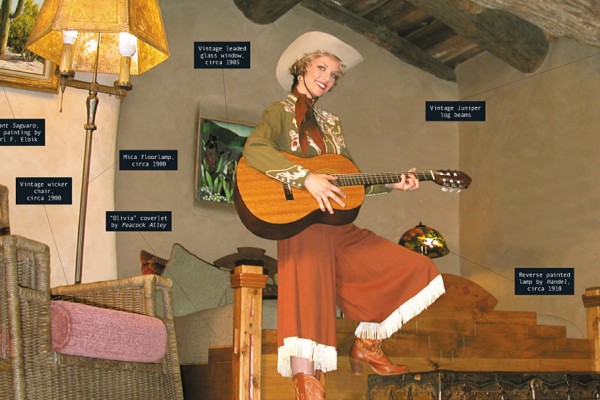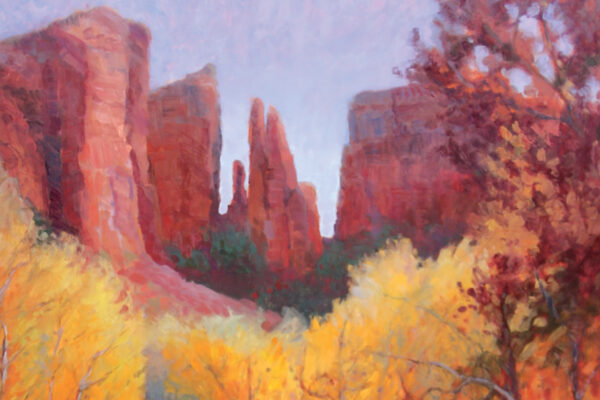In her letter, Ruth Jordan describes this Oak Creek scene: “While coats were being put around her, several spectators asked for permission to take pictures, which was allowed, even though she was shaking with the cold, and her teeth were chattering. Then, as she struggled up the rocky hill to dry clothes and warmth, one visitor even stopped her and asked for and received her autograph. It is easy to understand why her double, Sylvia LaMarr, has stayed with her eleven years, and thinks the world of Joan Crawford.”
But for all the good will Ruth Jordan saw, others stuck around to recount a less wholesome story. The next scene was of McCambridge forcefully addressing a posse; on the third take she gave an impassioned performance that drew loud applause from the director and crew. (Ray later described McCambridge’s portrayal of the nasty Emma as the screen equivalent of “sulfuric acid.”) Intently watching the proceedings from the top of the hill was a livid, trembling, competitive Crawford, who turned and stalked away. Ray later recalled, “I should have known some hell was going to break loose.”
McCambridge was Ray’s choice to play Emma, not Crawford’s; she preferred Bette Davis, Barbara Stanwyck or Claire Trevor for the role. But Republic was already paying Crawford $200,000–a bankroll that could finance four “Jubilee” westerns — and couldn’t justify another big salary.
Tensions between Crawford and McCambridge had been simmering almost since production began. In a curious twist on Johnny Guitar‘s fictional story, McCambridge had been teasing Crawford because she was married to a former boyfriend of Joan’s and took every opportunity to remind her of that fact. At the same time, McCambridge had been infuriated by rumors that Crawford was having an affair with Ray, assuming this would earn her preferential screen treatment; curiously, Joan suspected that Ray was giving Mercedes extra coaching on her role behind her back, giving her costar a chance to upstage her. It probably didn’t help matters that Crawford decreed McCambridge’s hair had to be died jet-black to contrast with her own warm russet-brown.
The evening of the Oak Creek incident, Ray found his reeling star (Crawford biographer Bob Thomas wrote she had traveled to Sedona with 20 cases of vodka) at a gas station near their hotel, angrily yelling into the payphone. “Goddammit,” she shrieked, “I want you to call the limousine service and have a limousine here for me first thing in the morning, get me out of here!” Ray also saw that Crawford had gone into the adjoining cabin at the Cedar where McCambridge was staying, removed her costumes and threw them all over the road. She eventually staggered back to the hotel and Ray quickly retrieved the strewn wardrobe.
The following morning, Ray switched cabins with McCambridge in a bid to separate the two actresses, but it didn’t do much to cool down the situation; that afternoon Crawford demanded rewrites on the script, as well as five new scenes to beef up her part. Ray figured that making the changes Crawford had in mind would add about $600,000 to the film’s budget; knowing full well that tight-fisted studio boss Herb Yates would hit the roof, Ray sent an urgent plea to Hollywood for help.
Joan’s agent, Arthur L. Park, was in Sedona the next day, having flown to Arizona on a plane chartered by MCA chief Lew Wasserman. Crawford informed Park that Vienna was to be the lead role, and that she had a limousine ready to take her back to Los Angeles if she wasn’t accommodated.
Park had been ordered by the studio to keep production going, so he agreed to Crawford’s demands. Later, he went to Ray to report the outcome, reminding him that Wasserman would not stand for the movie to be canceled. So the script for Johnny Guitar was reworked to soothe Crawford’s objections; much of the dialogue originally written for Sterling Hayden was given to her character; as a result, Vienna became more aggressive, while the Johnny Guitar character became softer and more ambivalent. The deal cost Republic $220,000 in added expenses.
Ironically, Crawford’s power play would account for the film’s most remarked upon characteristic: the kinky masculinity of the film’s lead female characters and the passivity of its males.
The Johnny Guitar set remained tense. Seeking publicity for the film, studio press agents arranged for a reporter from The Arizona Republic to come to Sedona to interview Crawford. Strict guidelines were set for the article; only Joan’s chosen photographer would be allowed to take her picture, and The Republic couldn’t run any shots unless she approved them first.
When Maggie Wilson, the Republic‘s reporter, arrived on the set from Phoenix on the prearranged day, Crawford’s staff informed the writer that their boss had changed her mind about being interviewed, but would do it the following Tuesday.



